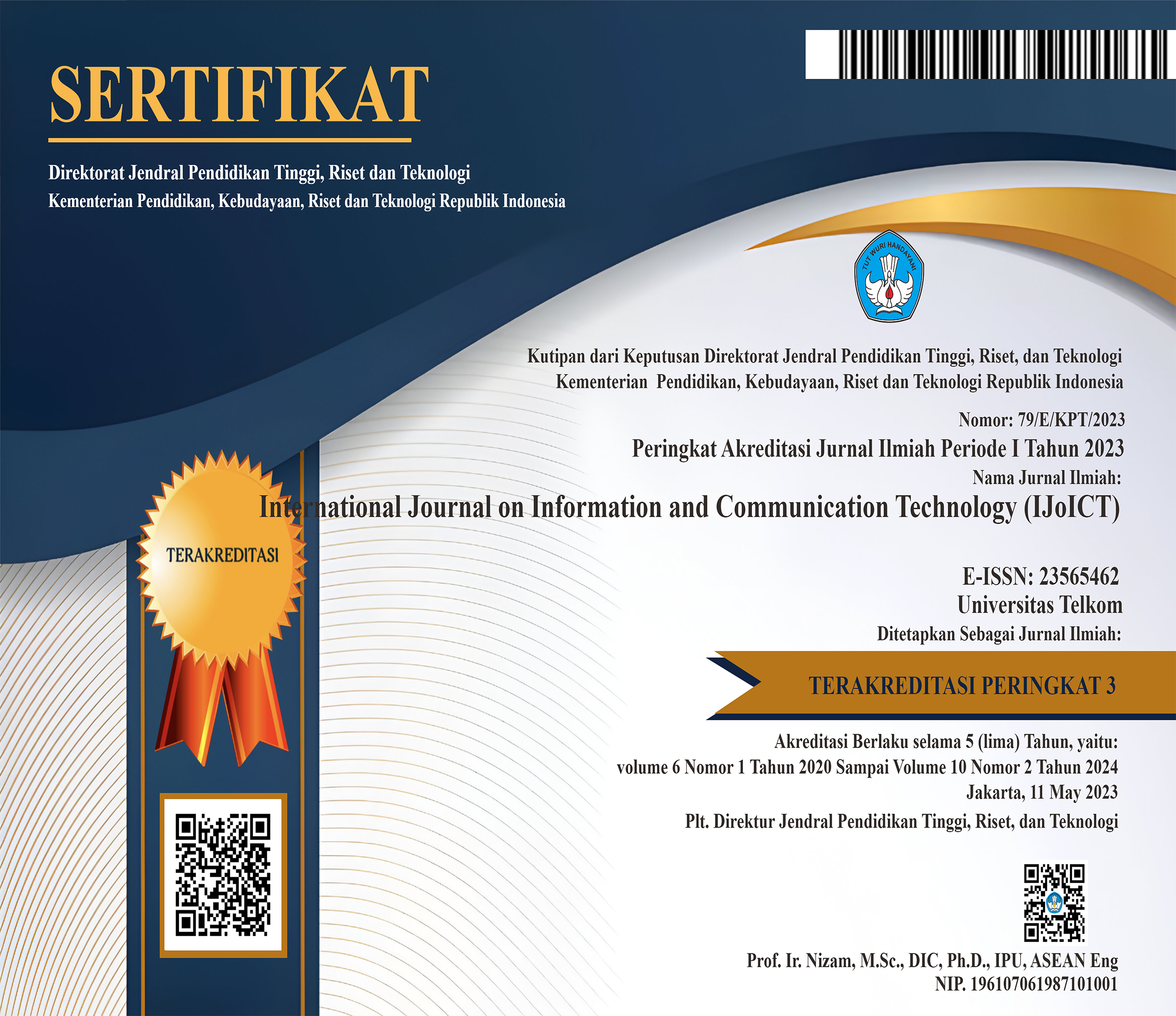Performance of Time-Based Feature Expansion in Developing ANN Classification Prediction Models on Time Series Data
 Abstract views: 86
,
Abstract views: 86
,
 pdf downloads: 63
pdf downloads: 63
Abstract
The prediction problem in most research is the main goal, to estimate future events related to the field under study. Research on classification that involves the prediction process in it, with spatial-time data and influenced by many features, such as the problem of disease spread, climate change, regional planning, environment, economic growth, requires methods that can predict while solving the problem of features and time. To obtain a time-based classification prediction model using many features, this research uses machine learning methods, one of which is Artificial Neural Network (ANN). The scenario carried out is to develop a t+r classification prediction model by expanding features based on the time t-r of the previous period. The performance of feature expansion in the development of ANN classification prediction models is determined based on the optimal accuracy value of the combination of t-r classification prediction models for the previous time period. By implementing the model on the data, it is found that the performance of time-based feature expansion in ANN classification ranges from 3.5% to 11%. While the optimal accuracy value is obtained from the feature expansion scenario of 3 to 5 time periods earlier.
Downloads
References
[2] Y. C. Liang, Y. Maimury, A. H. L. Chen, and J. R. C. Juarez, “Machine learning-based prediction of air quality,” Appl. Sci., vol. 10, no. 24, pp. 1–17, 2020, doi: 10.3390/app10249151.
[3] C. Anastassopoulou, L. Russo, A. Tsakris, and C. Siettos, “Data-based analysis, modelling and forecasting of the COVID-19 outbreak,” PLoS One, vol. 15, no. 3, 2020, doi: 10.1371/journal.pone.0230405.
[4] S. S. Prasetiyowati and Y. Sibaroni, “Prediction of DHF disease spreading patterns using inverse distances weighted (IDW), ordinary and universal kriging,” J. Phys. Conf. Ser., vol. 971, no. 1, pp. 0–15, 2018, doi: 10.1088/1742-6596/971/1/012010.
[5] D. Jang, “An Application of ANN Ensemble for Estimating of Precipitation Using Regional Climate Models,” Adv. Civ. Eng., vol. 2021, 2021, doi: 10.1155/2021/7363471.
[6] A. N. Sihananto and W. F. Mahmudy, “Rainfall Forecasting Using Backpropagation Neural Network,” J. Inf. Technol. Comput. Sci., vol. 2, no. 2, pp. 66–76, 2017.
[7] W. M. Ridwan, M. Sapitang, A. Aziz, K. F. Kushiar, A. N. Ahmed, and A. El-Shafie, “Rainfall forecasting model using machine learning methods: Case study Terengganu, Malaysia,” Ain Shams Eng. J., vol. 12, no. 2, pp. 1651–1663, 2021, doi: 10.1016/j.asej.2020.09.011.
[8] A. Y. Barrera-Animas, L. O. Oyedele, M. Bilal, T. D. Akinosho, J. M. D. Delgado, and L. A. Akanbi, “Rainfall prediction: A comparative analysis of modern machine learning algorithms for time-series forecasting,” Mach. Learn. with Appl., vol. 7, p. 100204, 2022, doi: 10.1016/j.mlwa.2021.100204.
[9] A. J. Lepperød, A. Jacobsen, and L. Ntnu, “Air Quality Prediction with Machine Learning.” 2019.
[10] S. M. S. Nagendra and M. Khare, “Artificial neural network approach for modelling nitrogen dioxide dispersion from vehicular exhaust emissions,” Ecol. Modell., vol. 190, no. 1–2, pp. 99–115, 2006, doi: 10.1016/j.ecolmodel.2005.01.062.
[11] A. S. Raj, R. J. Usha, S. Akshaya, K. Saranya, and D. Shyamilee, “Artificial Neural Network Model for Rainfall Data Analysis During 2004-2017 in Tamil Nadu, India – Prevailing Pattern Evaluation on Climate Change,” J. Model Based Res., vol. 1, no. 2, pp. 34–47, 2020, doi: 10.14302/issn.2643-2811.jmbr-20-3402.
[12] F. MinminMiao, HongZeng, AiminWang, ChangsenZhao, “Discriminative spatial-frequency-temporal feature extraction and classification of motor imagery EEG: An sparse regression and Weighted Naïve Bayesian Classifier-based approach,” elsevier, vol. 278, pp. 13–24, 2017.
[13] M. Akhter and M. A. Ahanger, “Climate modelling using ANN,” Int. J. Hydrol. Sci. Technol., vol. 9, no. 3, pp. 251–265, 2019, doi: 10.1504/IJHST.2019.102316.
[14] C. M. YE??LKANAT, “Spatio-temporal estimation of the daily cases of COVID-19 in worldwide using random forest machine learning algorithm,” Chaos, Solitons and Fractals, vol. 140, 2020, doi: 10.1016/j.chaos.2020.110210.
[15] J. I. abMunag. V.N.K.Prasadb, S.Nickolasa, and G.R.Gangadharan, “Representational primitives using trend based global features for time series classification,” elsevier, vol. 167, 2021, doi: https://doi.org/10.1016/j.eswa.2020.114376.
[16] L. Deng and D. Yu, “Deep learning: Methods and applications,” Found. Trends Signal Process., vol. 7, no. 3–4, pp. 197–387, 2013, doi: 10.1561/2000000039.
[17] H. Wang, R. Czerminski, and A. C. Jamieson, “Neural Networks and Deep Learning,” Mach. Age Cust. Insight, pp. 91–101, 2021, doi: 10.1108/978-1-83909-694-520211010.
[18] M. Robnik-Šikonja, “Explanation of prediction models with explain prediction,” Inform., vol. 42, no. 1, pp. 13–22, 2018.
[19] B. Nikparvar and J. C. Thill, “Machine learning of spatial data,” ISPRS Int. J. Geo-Information, vol. 10, no. 9, pp. 1–28, 2021, doi: 10.3390/ijgi10090600.
[20] K. L. Du, C. S. Leung, W. H. Mow, and M. N. S. Swamy, “Perceptron: Learning, Generalization, Model Selection, Fault Tolerance, and Role in the Deep Learning Era,” Mathematics, vol. 10, no. 24. MDPI, 2022, doi: 10.3390/math10244730.
[21] Y. S. Park and S. Lek, Artificial Neural Networks: Multilayer Perceptron for Ecological Modeling, vol. 28. Elsevier, 2016.
[22] V. E. Balas, N. E. Mastorakis, M.-C. Popescu, and V. E. Balas, “Multilayer perceptron and neural networks Analysis and Synthesis of perturbed Duffing oscillators’ View project Education View project Multilayer Perceptron and Neural Networks.” 2009, [Online]. Available: https://www.researchgate.net/publication/228340819.
[23] A. K. Sanjiv Storcheus Dmitry; Rostamizadeh, “A Survey of Modern Questions and Challenges in Feature Extraction,” 1st Int. “Feature Extr. Mod. Quest. Challenges,” vol. 44, pp. 1–18, 2015.
[24] Daeun Jung; Jungjin Lee; Hyunggon Park, “Feature expansion of single dimensional time series data for machine learning classification,” in IEEE Xplore, 2021, p. 181, doi: 10.1109/ICUFN49451.2021.9528690.
[25] J. Eden, “Expand Your Horizons,” 2021. .
[26] R. F. Ramadhani, S. S. Prasetiyowati, and Y. Sibaroni, “Performance Analysis of Air Pollution Classification Prediction Map with Decision Tree and ANN,” vol. 3, no. 4, pp. 536–543, 2024, doi: 10.47065/josyc.v3i4.2117.
[27] D. A. Petrusevich, “Features addition and dimensionality reduction in classification,” IOP Conf. Ser. Mater. Sci. Eng., vol. 919, no. 4, 2020, doi: 10.1088/1757-899X/919/4/042018.
[28] A. Gumilar, S. S. Prasetiyowati, and Y. Sibaroni, “Performance Analysis of Hybrid Machine Learning Methods on,” vol. 5, no. 158, pp. 481–490, 2022.
[29] C. Natalia, A. A. Rohmawati, and S. S. Prasetyowati, “Classification of COVID-19 Monthly Cases Using Artificial Neural Network ( ANN ) Method,” vol. 4, no. 1, pp. 33–41, 2022, doi: 10.47065/josh.v4i1.2236.

This work is licensed under a Creative Commons Attribution 4.0 International License.
Manuscript submitted to IJoICT has to be an original work of the author(s), contains no element of plagiarism, and has never been published or is not being considered for publication in other journals. Author(s) shall agree to assign all copyright of published article to IJoICT. Requests related to future re-use and re-publication of major or substantial parts of the article must be consulted with the editors of IJoICT.








.png)

.jpg)




